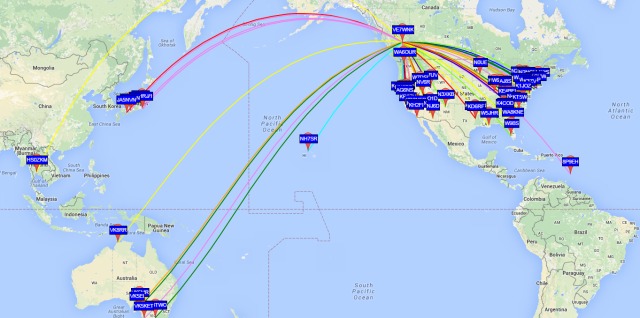Can you hear “Careless Whisper” without getting sucked into an earworm induced one-man hum-saxophone party? Naw, me neither…
It’s been a while since I have updated this page and I wanted to take a few moments to thank all of you who have been following.
Today we are going to be talking about a beacon mode known as WSPR, from K1JT, the author of JT65. WSPR works by sending a two minute (in WSPR-2 mode) long tone which slowly sends out a station’s call sign, TX power in dBm, and Maidenhead Grid Square. WSPR stands for Weak Signal Propagation Reporter, and as the name suggests protocol is for determining where the band is open to. WSPR does not require the band to be wide open, and in fact it seems to show the band open when it really is slammed shut. Due to the way it’s designed, the protocol does not need a perfect reception on the other side, thus making it suitable as a weak signal mode. While I believe WSPR is designed to be used with low power it seems many are using roughly 100 watts at times.
I thought it would be a decent way to test to my 80 meter antennas. Currently I have a North-South-broad 80 meter inverted-vee, an East-West-broad 80/40 fan-inverted-vee, and of course my 80 meter loop antenna. I set them up in an equal head to head to head.
The test was as follows:
- RX for 10 mins (5 cycles)
- TX for 2 mins (1 cycles)
- 10 watts TPO as measured at the rig.
- Repeated twice in a row A,B,C,A,B,C style so as to reduce the effects of band changes.
On the first test I was ‘spotted’ in Arizona and California on my North/South inverted-vee. I received stations in Texas, Oregon, and California. This did not really impress me as I can often hear guys in California on 80 at night. I blame my ridiculous noise floor for my failure to receive more stations. I will have a separate video and blog entry detailing my noise struggles.
Next, it was time to put the newest antenna to the test. I loaded up the East/West 80/40 inv-vee and it was stellar by comparison. The match on this antenna is poorer in the low band where WSPR operates, but has far superior free space around it. This antenna did not hear much better, same issue as before, but I did get a station from Nevada, somewhere in New England, and one in the Denver area. The second round on this antenna netted me more stations, but getting into W1 territory on 10 watts on 80 meters really had me on psyched up.
While still on a high from this very positive result I opted to test out the loop to see what kind of pattern it offered. After 15 minutes I had no new stations, and it seemed to mirror the N/S vee perfectly. A longer test may be required, but I had other plans for my evening. I hope to leave the radio on this antenna one night in the near future. It is worth mentioning that the night that I did this there was substantial aurora visible in my area and the scope showed no other stations on the band.
Now, this is where things got fun. 80 was a relatively soggy band last evening, so I played around on 40 meters. A few TX’s netted me Australia, Barbados, and the East Coast! This was a blast! That night I would leave the radio on while I slept and it would transmit about once an hour, but would spend most of the night receiving. When I woke up I nearly coated everything in coffee when I spotted Thailand had not only heard me, but I had heard them! I was shocked! THRILLLLED! You can see the live map at any time here.

Hawaii, Thailand, and the East Coast on 40 meter WSPR.
My next plan is to do the same on 20 meters. I have two antennas, a 20 meter monoband vertical that I made a few years back. Originally, this antenna was for 10 meters, however when I planted it here in Quesnel the radials doubled in length, quadrupled in number, and grew to 1/4 lambda on 20. This antenna is not ideal, but it loads up perfectly and might be suitable for this test. My second antenna on 20 is actually my 80 meter loop which loads up nicely on 20.
Overall this may be my new favorite digital mode. I did have some challanges with getting the software running, but once I got those worked out I was able to get it working with the IC7600 without any additional hardware required. I found that I was getting better results with WSPR-X as it was better suited to the audio issues with the IC7600′s Texas Instruments PCM2901 and Windows 7. Yet another reason to move to Win 10? Maybe, maybe not…
For now, thanks again for reading and I wish you a brilliant holiday season and all the best for the New Year.

